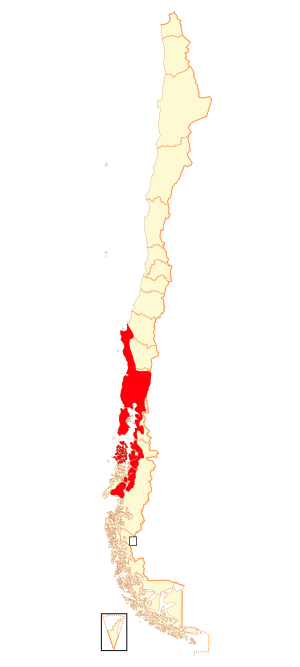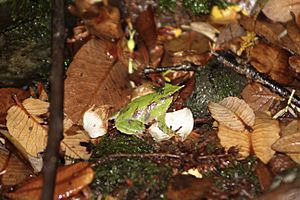Darwin's frog facts for kids
Quick facts for kids Darwin's frog |
|
|---|---|
 |
|
| Conservation status | |
| Scientific classification | |
| Genus: |
Rhinoderma
|
| Species: |
darwinii
|
 |
|
| Range in Chile in red (also occurs in adjacent southwestern Argentina) | |
The Darwin’s frog (Rhinoderma darwinii), also known as the Southern Darwin's frog, is a special type of frog. It lives in Chile and Argentina. The famous scientist Charles Darwin discovered this frog during his trip on HMS Beagle to Chile.
In 1841, two French zoologists, André Marie Constant Duméril and Gabriel Bibron, officially described and named the Darwin's frog. These frogs mostly eat small plant-eating bugs. Sadly, the Darwin's frog is now an endangered species. This means it is at high risk of disappearing forever.
Darwin’s frog is most famous for its amazing way of raising its young. The male frog keeps the developing tadpoles safe inside his own vocal sac. This unique "mouth brooding" behavior makes the Darwin's frog very special. Only one other frog, the R. rufum, might do this too, but it might already be extinct.
Contents
What Does It Look Like?
Size
Darwin's frogs are quite small. They are usually about 2.2 to 3.1 centimeters (less than 1.5 inches) long from their snout to their rear end. Their snout is long and fleshy, making their head look like a triangle. Their legs are long and thin. Their front feet do not have webs, but some of their back toes usually do.
Coloration
The top part of these frogs can be different shades of brown or green. Some brown frogs might have faint V-shaped marks on their back. Their middle back might be lighter brown than their sides. Their front legs can be whitish.
Female frogs are usually brown. They tend to stay on surfaces that match their color. Male frogs have more varied colors and can be found on many different surfaces. Brooding males (dads carrying tadpoles) are often partly or completely green on top. The frog's throat is brownish, and its belly is black with large white spots. Each frog has a unique pattern of these white spots.
Scientists have seen male R. darwinii change color in zoos. Frogs that were brown at first turned green over a year. This color change might happen because of the green environment they live in.
Where Do They Live?
Darwin's frogs live in Chile and Argentina. They are mostly found in the Valdivian temperate rain forest. This forest covers parts of both countries. In Chile, they live from Concepción Province to Palena Province. In Argentina, they are found in Neuquén Province and Río Negro Province.
You can find them in forest clearings and wooded areas up to about 1,100 meters (3,600 feet) above sea level. They like bogs and areas near slow-moving streams. They seem to prefer a mix of grassy areas, moss, fallen wood, and young trees in an old native forest. Short plants help keep the ground moist and cool, and also hide them from predators.
Sadly, their habitat is shrinking. In the north, pine and eucalyptus farms are replacing native forests. This pushes the frogs further south. The southern Valdivian forest is more protected and better for them.
Climate change is also a threat. Scientists expect wildfires to increase a lot, which will harm the frogs' homes. Also, the frogs might not be able to move to new suitable habitats that appear due to climate change, because they don't travel far.
How Are They Being Protected?
Darwin's frog numbers have dropped a lot. This is mainly because their homes are being destroyed or changed. Native forests are being turned into tree farms.
Since 2018, the IUCN Red List has listed the species as Endangered. This means they are at a very high risk of extinction. A study in 2013 found the frog in only 36 out of 223 places where it used to live. The populations in these places were very small.
In October 2021, the IUCN also classified R. darwinii as Critically Depleted. This means the species' survival depends a lot on conservation efforts. Luckily, it has a good chance of recovering if we help.
Conservation Efforts
Because their numbers are declining in the wild, some zoos have started special breeding programs. These programs help keep the frogs safe in captivity. Two zoos in Chile, the Chilean National Zoo and Concepción Zoo, are working with international partners to do this.
In 2017, a group of 30 different countries formed a Binational Conservation Strategy. Their goal is to study R. darwinii and improve ways to protect it. They believe the frog's unique mouth brooding behavior makes it especially important to save. The group aims to learn key information about R. darwinii by the year 2028.
What Do They Eat?
Darwin's frogs eat different kinds of small invertebrates (bugs without backbones). They eat bugs that feed on dead stuff, plant-eating bugs, and even meat-eating bugs. They seem to eat each type of bug based on how common it is in their environment.
They eat fewer meat-eating bugs than plant-eating bugs. This is because spiders are the main meat-eating bugs they meet. Spiders are very good at escaping from the frogs.
Scientists have noticed that places where Darwin's frogs live often have many plant-eating bugs. This might mean that the frogs look for places with lots of these bugs to eat. Darwin's frogs usually "sit and wait" for their prey. This hunting method saves energy and helps them avoid predators.
How Do They Reproduce?
Male R. darwinii frogs call out to attract females for mating. They even call when they are brooding (carrying tadpoles). These frogs use special sounds to communicate and attract mates. Scientists are still studying their mating patterns.
Females usually lay 4 to 10 eggs at a time. Males can carry 5 to 8 tadpoles in their vocal sac. Sometimes, a female R. darwinii can lay up to forty eggs in a single leaf litter.
Amazing Parental Care
After about 3 to 4 weeks, the male frog notices the baby frogs (embryos) starting to move inside the eggs. Then, he swallows the eggs and keeps them safe in his vocal sac. Most males that do this are green. The eggs hatch about 3 days later. The father continues to carry the tadpoles in his vocal sac. There, they feed on their egg yolks and special fluids from the sac wall until they change into tiny frogs.
It was once thought that the male frog did not eat for 6 weeks while carrying tadpoles. However, in 1888, a scientist found beetles and flies in a brooding male's stomach. This showed that the father does still eat during this time. After the tadpoles become tiny frogs, they hop out of the male's mouth and go their own way.
In zoos, scientists have seen R. darwinii parents leave their eggs alone for about 3 weeks. Some males will guard the eggs during this time. Also, male frogs in captivity have shown "alloparental behavior." This means they take care of eggs or tadpoles that are not their own. Foster fathers have been seen protecting eggs and even carrying other males' tadpoles.
In one experiment, a foster father swallowed 8 tadpoles, but only 2 frogs came out. This means not all tadpoles survive the process. Scientists have two main ideas why males might care for other frogs' young:
- Practice Makes Perfect: Foster fathers might be practicing their brooding skills. Better skills mean they can raise more of their own babies later.
- Showing Off: Foster fathers might be showing off their past success to future mates. They hope that females will see them caring for young and be more likely to mate with them.
These ideas suggest that there is a benefit for males who care for offspring that are not theirs.
Threats to Their Survival
Darwin's frog is very sensitive to a disease called chytridiomycosis. This disease is caused by a fungus called Batrachochytrium dendrobatidis. Even though Darwin's frogs seem less affected by this fungus than other amphibians, it can still infect and kill them. Past studies suggest that this disease might be partly responsible for the drop in Darwin's frog numbers in Chile and Argentina.
Interestingly, recent studies show something unusual. In populations where many frogs have the fungus, the population actually grows faster. And in populations with low infection rates, the population grows slower. This means that even if some frogs die from the infection, more babies are being born.
Scientists call this the "parasite-induced plasticity" hypothesis. It suggests that infected frogs put more energy into having babies instead of surviving longer. This happens over one generation. This behavior helps the frog pass on its genes before the infection takes over.
Used in Research
Darwin's frogs have been used to study how the size of cold-blooded animals (ectotherms) changes. They help scientists understand how body size relates to different climates. Because Darwin's frogs live in many different habitats, researchers can study the same species in various climates. This helps them learn about how body size is linked to seasons and climate.
See also
- Gastric-brooding frog
- Mouthbrooder
 In Spanish: Rana de Darwin para niños
In Spanish: Rana de Darwin para niños




